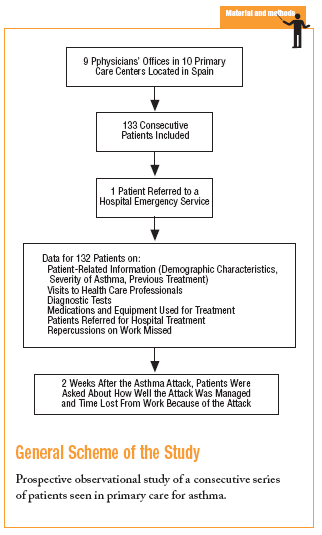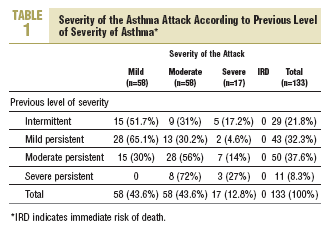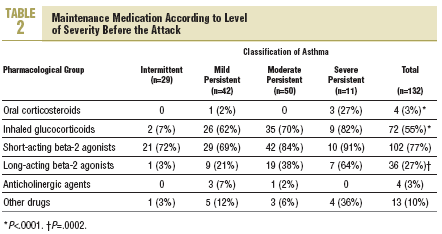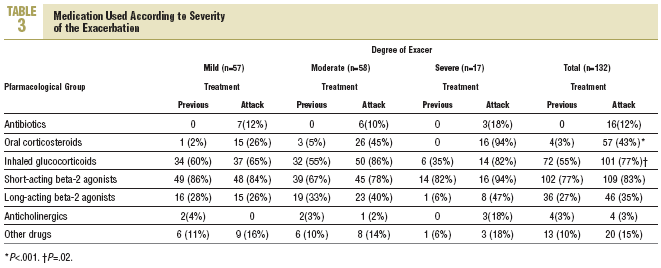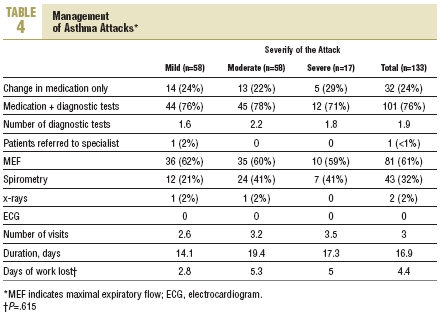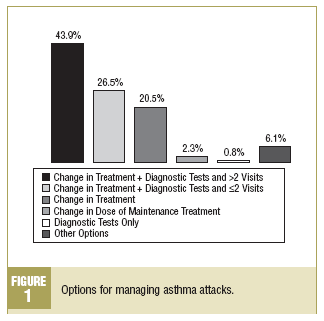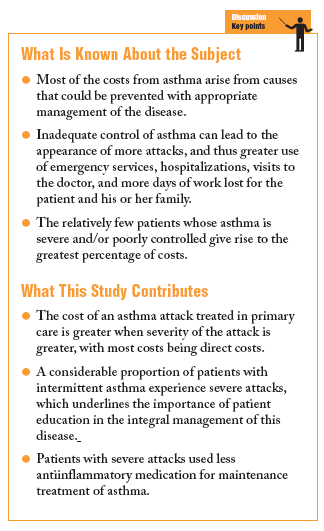Introduction
The prevalence of asthma, a chronic inflammatory respiratory disease, is on the rise in developed countries,1 where it represents a considerable health and economic problem. Exacerbations and attacks contribute to the increase in resource utilization and limit patients' activities of daily living.2-4
Health costs can be divided into 3 categories: direct, indirect, and intangible.5 Direct costs (DC) are related with the resources consumed (medications, hospital admissions, diagnostic tests, health care personnel costs), whereas indirect costs (IC) are related with reduced productivity owing to illness (sick leave and incapacity for work, early retirement, and premature death) and intangible costs refer to potential earnings lost because of illness.
Studies in a number of countries have found DC and IC to be similar.6 Moreover, costs arising from asthma attacks represent 33% of all DC and 100% of all IC, or 70% of the total cost of the disease. This situation suggests that the disease is inadequately controlled, and that this in turn leads to an increase in the number and severity of attacks, the number of visits to the doctor, visits to emergency services, diagnostic tests, hospitalizations, and time off from work because of sick leave.5,6
To date, studies of the costs arising from asthma have been carried out in hospital settings, and there are no studies of the cost of asthma attacks in Spain. The aims of the present study were therefore to estimate the cost of asthma attacks treated in primary care and characterize the management of exacerbations in primary care.
Patients and Methods
This prospective, observational study was carried out in 10 physician's offices at 9 health centers located in 5 provinces in Spain. Participants were chosen from among family physicians interested in respiratory problems, and the study included consecutive patients seen for asthma attacks during a 12-month period.
Variables Recorded
1. Patient-related variables: demographic information, severity of asthma, exacerbation according to GINA criteria, maintenance medication, other respiratory diseases.
2. Resource-related variables:
Visits to health care professionals: visits, actions taken as a consequence of exacerbation (medications and tests done, home visits, visits to the health center as a consequence of exacerbation).
Diagnosis: pulmonary function tests (spirometry, maximal expiratory flow [MEF], pulse oximetry). Other tests (ECG, x-ray, blood gases, etc).
Medications and equipment used to treat exacerbations of asthma (type, route, frequency, apparatus used, pharmaceutical form and duration of treatment, spacers, flow meters, nebulizers).
Consultations that resulted in referral to hospital care.
3. Actions taken by the patient to control the exacerbation.
4. Repercussion of the exacerbation of asthma on work absenteeism
5. Number of hours of work lost because of exacerbation.
The criteria for considering the attack resolved were return to habitual medication for the treatment of asthma and/or use of fewer than 4 puffs or blisters per day during at least 2 consecutive days on rescue medication.
Subjects
One hundred and thirty three consecutive patients followed at the participating offices (between 10 and 14 patients per physician). Inclusion criteria were prior diagnosis of asthma in the patient's medical record, age older than 14 years, and asthma attack motivating an unscheduled visit to the primary care center. Participation in other asthma studies also made the patient ineligible for inclusion. Exclusion criteria were second or subsequent episodes of asthma attack, and visit to the emergency service for asthma attack.
Two weeks after the initial consultation the patient was asked whether the attack had been managed successfully and how much time had been lost from work because of the attack.
The GINA criteria1 were used to classify patients according to degree of severity of asthma prior to the attack and severity of the attack itself.
Ethical issues: all patients were managed according to habitually used treatment measures. No predetermined pharmacological interventions were used.
Data Analysis
Costs were analyzed in relation to the severity of the attack and the severity of the disease before the attack, in terms of costs7 to the Spanish National Health System (direct costs [DC]) and in terms of costs to society (DC plus indirect costs [IC]).8 We used data from official sources available at the time of analysis (year 2000).
The costs of exacerbation of asthma were estimated per patient for this study.
Direct costs were defined as the following: medication for the attack, visits to the family physician, visits to specialists, diagnostic tests, and equipment used. Indirect costs were recorded here as time lost from work.
Data Processing
All data were entered into an Excel spreadsheet and processed with the Statistical Analysis System (SAS) statistical package.
Descriptive statistics are reported for the variables studied here. Normal distribution was verified with the Kolmogorov-Smirnov test. Nonparametric tests were used to compare costs. Bivariate analysis with two-by-two comparisons was used to contrast independent variables with the dependent variable, with the Kruskal-Wallis and Mann-Whitney U nonparametric tests. A bootstrapping technique was used to calculate confidence intervals.9
A 5% level of confidence was used.
Univariate sensitivity analysis was used to analyze the robustness of the results for the fundamental variables and facilitate extrapolation.10
The data used as a reference to calculate costs of an asthma attack treated in primary care were obtained from the database maintained by the Consejo General de Colegios Oficiales de Farmacéuticos (General Council of the Official Colleges of Pharmacists), the database of health care costs maintained by SOIKOS, and from the Instituto Nacional de Estadística de España (Spanish National Institute of Statistics).11-13
Results
Of the total sample of 133 patients with an asthma attack, 35 (26%) were men and 98 (74%) were women. Mean age was 47.8 years. One third (44 patients, 33%; 15 men and 29 women) were employed at the time of the exacerbation. One patient was referred to a hospital emergency service, so costs were calculated here for a total sample of 132 patients.
Table 1 shows the figures for severity of the attack according to previous degree of severity of asthma; 21.8% of all attacks occurred in patients with intermittent asthma. Table 2 summarizes the maintenance treatments used before the exacerbation. The figures show that the more severe the attack, the less frequent prior treatment was with inhaled corticosteroids (Table 3).
Table 4 and Figure 1 illustrate how asthma attacks were managed. The most habitual form of management was "change in treatment, diagnostic tests and more than 2 appointments with the doctor."
Mean total cost of an asthma attack treated in primary care was e166.7 euros (95% CI, 146.5-192.3). Direct costs represented almost 80% of the total cost, with 20% of the DC arising from prescription medication and use of medications and equipment, and 80% from consultations and diagnostic tests. In relative terms, more severe exacerbations were associated with lower costs for consultations and diagnostic tests, and higher costs for medication and equipment (Table 5).
Direct costs were also higher for unemployed patients (140.8; 95% CI, 127.1-156.3). Although the number of patients who were employed was small (44), we noted that in this group DC (53%) tended to be more similar to IC (47%).
Because of the variability in costs arising from visits to the primary care center and the influence of this expense on the total costs of asthma attacks, we performed a sensitivity analysis of this variable to determine the consistency of the results. Sensitivity analysis showed that the cost of an asthma attack treated in primary care ranged from e103.2 to e166.7.
Discussion
Asthma attacks account for 70% of all costs arising from illness, especially because of the IC involved.5,6 Although one earlier study has appeared on the costs of asthma in Spain,14 and one other study investigated the costs of asthma attacks,15 no studies have appeared to date on the costs of the exacerbation of asthma in primary care in Spain. We thus felt there was a need to calculate the utilization of resources as an initial step toward studying how to reduce the incidence of asthma attacks and the health costs they originate.
Studies published thus far on the costs of asthma are not comparable owing to differences in cultural and economic characteristics and differences in health and social service coverage between the countries where these studies have been done. Moreover, these studies did not consider the same variables (different components of the costs, different costs of the components, different populations, etc). Many studies referred to the costs of asthma in the hospital setting, whereas others16-19 pooled costs without distinguishing between primary and hospital care. Some have examined the impact of a given intervention (for example, patient education20-23) on total costs, while others have looked at the benefits of introducing preventive treatments24-26 (especially inhaled corticosteroids) in decreasing the costs related with asthma. Other studies have analyzed costs according to specific features of the disease4,27,28 (degree of severity, age, etc).
The present study attempts to determine the mean cost of an asthma attack treated in primary care within the Spanish National Health System. The high percentage of patients with intermittent asthma who had severe attacks (17.2%, Table 1) deserves particular mention. This may be related with denial of the disease, initial underestimation of the symptoms of an attack, or overestimation of self-control of the disease. Moreover, physicians may misdiagnose the disease or provide inadequate follow-up, or adherence with recommendations and prescribed treatments may be insufficient.28,29 We note that patients with severe persistent asthma did not have mild attacks. In this case, regardless the suitability of and adherence to the prescribed treatment, these patients may underestimate mild symptoms they are accustomed to because of their already severe illness.
When we looked at treatment prior to the attack, we found that the more severe the attack, the less likely it was that the patient had been using previous treatment with inhaled corticosteroids and/or long-acting beta-2 agonists (Table 3). This may be why attacks in these patients were often more severe, and the finding corroborates the results of earlier studies that found that continued treatment with antiinflammatory drugs was effective in reducing the number of asthma attacks, thereby reducing costs associated with this disease.24,26
For most patients (90.9%) the treatment they had been using before the asthma attack was changed (Figure 1). In most cases (77%) the maintenance treatment based on short-acting beta-2 agonists was judged inadequate, and this figure was higher than in the AIRE study (66%).29 The difference supports the notion suggested by Barnes et al6 that the cost of rescue treatment is greater than the cost of effective maintenance treatment.
Mean total cost of the management of an asthma attack in primary care was e166.7, 80% of which reflected DC. The higher proportion of DC in our study (80%) reflects the cost of diagnostic tests and doctor's visits, and is similar to the figure found by Hoskins et al15 (90%). To improve these results, the solution may lie in preventing the appearance of asthma attacks with effective maintenance treatment. In employed patients, total costs were 1.5-fold as high (e218.5) as in patients who were unemployed, and DC (53%) and IC (47%) tended to be similar in the former, particularly for moderate and severe attacks. Employed patients probably wait until their symptoms are more severe than unemployed patients would before seeking medical care. One limitation of this study is that we were not able to consider intangible costs, i.e., the time lost in patients who were unemployed. Although these costs may be considerable, they are difficult to measure reliably and objectively.
As found in earlier studies,14,16 costs increased with the severity of the attack. However, costs arising from doctor's visits and diagnostic tests were lower for severe than for moderate attacks. This may be a result of the fact that for severe attacks, more aggressive treatment with oral corticosteroids is begun without waiting for complementary tests. Oral corticosteroids are cheaper than inhaled treatments, and this approach to management obviates or reduces the need for the doctor´s visits and diagnostic tests which can arise from inappropriate or more conservative management.
The management option involving the lowest costs was to change pharmacological treatment, perform diagnostic tests and have the patient attend 2 follow-up appointments with the physician, mainly because IC are lowest with this option.
It is therefore necessary to emphasize the importance of appropriate management of the disease, with the use of effective continued treatment in accordance with the level of severity. This approach would probably improve the patient's quality of life and decrease the number and severity of attacks. This would probably result, in turn, in considerable reductions in the personal and social costs of asthma.
Future studies should be designed to obtain information on the factors that influence differences in costs according to the severity of the attack. This information may suggest ways to improve the distribution and use of resources in order to decrease the incidence of asthma attacks, and to reduce the costs they give rise to when they do occur.
Acknowledgments
We thank Dolores Fraga Fuentes of the Department of Scientific Information at GlaxoSmithKline for her unstinting help and continued support.







